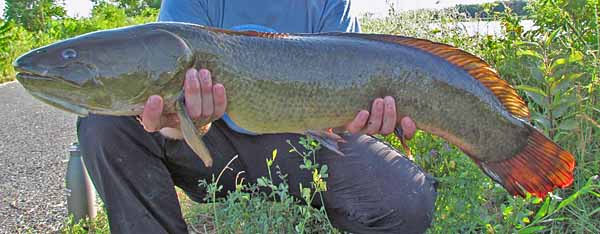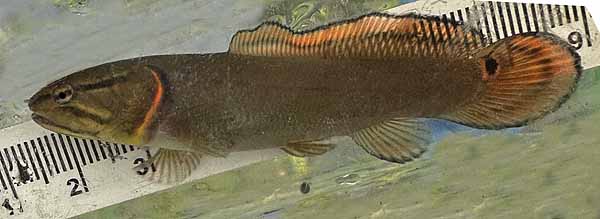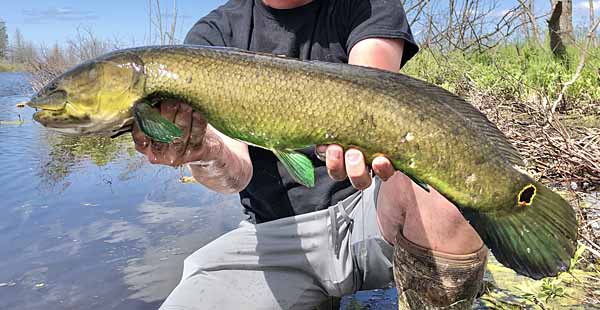Amia ocellicauda
Richardson, 1836
|
Familie: Amiidae SynonymeAmia canina Valenciennes in Cuvier & Valenciennes, 1847 Lokale Bezeichnung |
 Amia ocellicauda (adult; USA, New York, St. Lawrence County) -- (c) Corwin Andrews; iNaturalist; BY-NC 4.0  Amia ocellicauda (semiadult; Kanada, Ontario, Leeds and Grenville) -- (c) Josh Van Wieren; iNaturalist; BY-NC-ND 4.0 |
Typen
Holotypus: verschollen .
Siehe: Eschmeyer, W.N., Fricke, R. & Van der Laan, R. (eds.) 2024. Catalog of Fishes electronic version
Typusfundort: Huronsee, Nordamerika.
Etymologie
Ocellus (= Augenfleck); cauda (= Schwanz oder Schwanzflosse), ein Hinweis auf den Augenfleck am Ansatz der Schwanzflosse.
Verbreitung
Einzugsgebiet der Großen Seen bis zum Mississippi, westlich der Appalachen, im Südosten Kanadas und der Vereinigten Staaten.
IUCN Status

EX Extinct (ausgestorben)
EW Extinct in the Wild (in der Natur ausgestorben)
CR Critically Endangered (vom Aussterben bedroht)EN Endangered (stark gefährdet)
VU Vulnerable (gefährdet)
NT Near Threatened (potenziell gefährdet)
LC Least Concern (nicht gefährdet)
RE Regionally Extinct (regional oder national ausgestorben)DD Data Deficient (ungenügende Datengrundlage)
NE Not Evaluated (nicht beurteilt)
Status: Stand 19.08.2023: NE Not Evaluated (nicht beurteilt)
Gefahren für diese Art: (nicht beurteilt)
Literatur
- Richardson, J. 1836. The Fish. In: Fauna Boreali-Americana; or the zoology of the northern parts of British America: containing descriptions of the objects of natural history collected on the late northern land expeditions, under the command of Sir John Franklin, R.N. J. Bentley. Part 3: i–xv + 1–327, Pls. 74–97. Zitatseite [:236, !!]
- DeKay, J.E. 1842. Zoology of New-York, or the New-York fauna; comprising detailed descriptions of all the animals hitherto observed within the state of New-York, with brief notices of those occasionally found near its borders, and accompanied by appropriate illustrations. Part IV. Fishes. W. & A. White & J. Visscher, Albany. (als Teil von: Natural History of New York). i-xv + 1-415, Pls. 1-79. (BHL) Zitatseite [:269, Pl. 39 (fig. 125), !!, als Amia occidentalis]
- Cuvier, G. & Valenciennes, A. 1847. Histoire naturelle des poissons. Tome dix-neuvième. Suite du livre dix-neuvième. Brochets ou Lucioïdes. Livre vingtième. De quelques familles de Malacoptérygiens, intermédiaires entre les Brochets et les Clupes. P. Bertrand, Paris. v. 19: i-xix + 1-544 + 6 pp., Pls. 554-590. (BHL) Zitatseite [:424, Autor: Valenciennes, !!, als Amia canina; :412, Pl. 577 [nicht 543], !!, als Amia marmorata; :420, !!, als Amia ornata; :431, !!, als Amia reticulata; :427, !!, als Amia subcoerulea; :421, !!, als Amia viridis]
- Duméril, A.H.A. 1870. Histoire naturelle des poissons, ou, ichthyologie générale. Tome Second. Ganoïdes, Dipnés, Lophobranches. Roret, Paris. 2: 1-624, Atlas: pp. 9-12, Pls. 15-26. (BHL) Zitatseite [:423, !!, als Amia piquotii; :419, !!, als Amia thompsonii]
- Smith, C.L. 1986. The inland fishes of New York State. New York State Department of Environmental Conservation, Albany. i-xi + 1-522, Pls. 1-8. Zitatseite [:59; Synonyme: Amia thompsonii]
- Grande, L. & Bemis, W.E. 1998. A comprehensive phylogenetic study of amiid fishes (Amiidae) based on comparative skeletal anatomy: an empirical search for interconnected patterns of natural history. Soc Vert Paleont Mem (Suppl J Vert Paleont), 4: 1–690. Zitatseite [:33; Synonyme: Amia canina, Amia marmorata, Amia reticulata, Amia subcoerulea]
- Brownstein, C.D., Kim, D., Orr, O.D., Hogue, G.M., Tracy, B.H., Pugh, M.W., Singer, R., Myles-McBurney, C., Mollish, J.M., Simmons, J.W., David, S.R., Watkins-Colwell, G., Hoffman, E.A: & Near, T.J. (in press): Hidden species diversity in a living fossil vertebrate. bioRxiv preprint (doi) Zitatseite [:4; Synonyme: Amia occidentalis, Amia ornata, Amia piquotii, Amia viridis]

